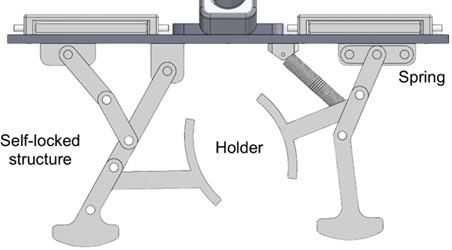A Design of Bionic Gripper to Enhance the Persistence of Wild Life Monitoring Performed by Drone
Abstract
In recent day, drones has become an essential tools in environmental observation and wildlife animal monitoring. It is undeniable that the effectiveness of this tool is often limited by challenges in landing and energy efficiency, particularly in dense forest environments. To address this potential problems, this study proposes a bionic gripper which is inspired by bird talons for enhancing drone landing capabilities, enabling a stable landing on complex environments for example tree branches. The gripper features a self-locking mechanism, which highly reduces the energy consumption while maintaining a stable and reliable holding. Using SolidWorks and Fusion 360, the gripper was designed and stimulated for a lightweight and adaptive performance. A key application of this technology is in the conservation for endangered species such as crested-ibis. This system is allowing drones to conduct long-term, low-disturbance observation, which not only extends the operation time but also minimizes the interference from noises, that contributes to a more sustainable and effective wildlife research as well as environmental monitoring.
References
[2] Lee, H., & Kim, S. (2020). Biomimetic Design of Robotic Grippers Inspired by Avian Morphology. Bioinspiration & Biomimetics, 15(4), 045002.
[3] Zhang, L., et al. (2022). Conservation Strategies for the Crested Ibis: Challenges and Opportunities. Conservation Biology, 36(5), e13987.
[4] Chen, Y., & Wang, Q. (2019). Energy Optimization in UAV Systems: A Review. IEEE Transactions on Robotics, 35(6), 1345-1360.
[5] Taylor, G., et al. (2023). Finite Element Analysis of Lightweight Robotic Structures. Robotics and Computer-Integrated Manufacturing, 82, 102543.
[6] Johnson, M., & Patel, R. (2021). Non-Invasive Technologies for Wildlife Conservation. Ecological Applications, 31(2), e02234.
[7] Liu, Y., Chen, R., & Wang, T. (2023). Bioinspired drone technologies for ecological monitoring in forest canopies. Journal of Environmental Robotics, 15(2), 101–115.


This work is licensed under a Creative Commons Attribution 4.0 International License.
Copyright for this article is retained by the author(s), with first publication rights granted to the journal.
This is an open-access article distributed under the terms and conditions of the Creative Commons Attribution license (http://creativecommons.org/licenses/by/4.0/).








1.png)














